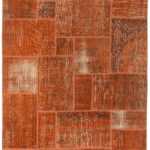How to Clean and Maintain Your Handmade Rug
Cleaning and maintaining your rug is wildly important if you want to preserve it. Handmade rugs can last decades with the right care, so it’s a worthwhile effort. While some machine-made rugs can be thrown in the washing machine, ease of cleaning doesn’t outweigh the numerous reasons handmade rugs are a superior choice.
To keep the stress of cleaning low, let James Royce help guide you through the process.
Vacuuming
Regular vacuuming is key, but do not over vacuum. While it may not show right away, doing so may wear down the pile. Still, without consistent vacuuming (at least once a week), grit and dirt will work their way down to the rug’s foundation. These abrasions can damage the wool or other fibers.
If it’s especially dirty, roll it up and take it outside to shake out before vacuuming.

Stain and Spot Removal
Timing is key to getting stains out of your rug. Most cleaning follows the same general pattern:
1. Blot the spill until the moisture is gone. Do not rub as it will result in the stain spreading.
2. Treat with the designated cleaner for your type of stain (see below for a few of the major stain types). Use a sponge and dab. Treat until the stain is gone.
3. Blot with a damp cloth to remove the remnants of the treatment.
4. Press a clean, dry towel over the area to remove all moisture.
5. Brush lightly with a carpet brush to avoid matting.
Common Spots and Spills


Coffee, tea, juice, and Soda:
These beverages may require cold water and diluted carpet shampoo if the stain is deep. Then, apply stain remover.
Red wine or dyed beverages:
In cases of red stains, use stain remover or equal parts cold water and white vinegar.
Sauces:
For red sauces and similar dark food stains, use diluted carpet shampoo and stain remover.
Pet stains:
For fresh pet stains, clean with cold water, diluted carpet shampoo, and stain remover.
For old pet stains, use stain remover and disinfectant.
Always test any cleaning agent in a small corner of your rug to make sure it doesn’t affect the dyes. No treatment is guaranteed to work, but it has the best chance when you act with urgency.
For a more detailed list of stain types and methods of treatment, see the Creative Matters Maintenance Guide
Professional Cleaning
While regular maintenance is your best option, get your handmade rug professionally cleaned periodically. If you take care of it, you will not have to do this as often, though if your rug is in a high-traffic area, it may need professional treatment regardless. Otherwise, this is only necessary every few years.
Invest in a professional who knows how to clean handmade rugs. Handmade rugs do not mix well with water, so we recommend finding an experienced company who performs steam cleaning or hot water extraction so they do not damage the rug while cleaning it.
Other
1. Loose Threads: occasionally, new handmade rugs can shed at first while the sheared fibers are still loose. If you experience this, shake out your rug and give it a little time for all the cut threads to fall out. If a thread becomes loose over time, cut it carefully. Pulling on it may damage your rug.
2. Rotate: rotate your rugs 180° every few months to balance the wear and impacts of sun fading.
3. Sun Fading: to keep your rug bright and beautiful, cover your windows with UV film, blinds, or curtains, especially at the height of the day.
4. Moths: Moths are a danger to any cloth or fabric, and rugs are no different. Moths are more likely to hide in dark, covered areas, so you should regularly vacuum the parts of your rug that are tucked under furniture. Products containing magnesium or zinc fluorosilicate are effective for moth-proofing, but they only last until you clean the rug. Test products in a small area of the rug first to make sure it does not hurt your rug.
5. Rug Type: Different rug materials may require different cleaning methods or frequencies. For example, more delicate materials like silks need a gentler hand than a wool rug.
Handmade rugs are very durable, but for long-term preservation, maintenance and care are pivotal.
Learn something? Share it!





Pingback: Interior Design & Modern Office Life - James Royce